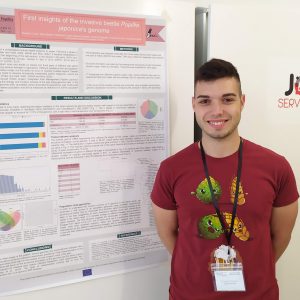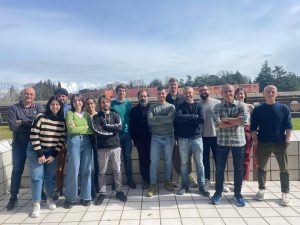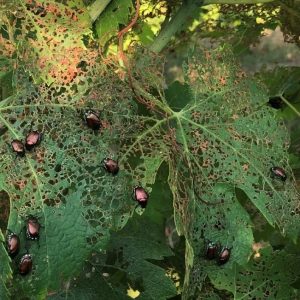The research project of the ESZlab group in the international consortium IPM-Popillia
In a globalized world, invasive species pose a significant concern due to their rapid spread and ability to adapt to new environments.

Among them Popillia japonica, known as the ‘Japanese beetle’, is an agricultural pest that arrived in Italy 10 years ago and continues to cause economic damage in the northern regions of the country and the most serious concerns at the European level.
“Japanese beetles have never been a major problem in their native country (ed. Japan), but they quickly became a significant agricultural and home garden pest in non-endemic areas” says Claudio Cucini, a post-doctoral researcher in the Department of Life Sciences of the University of Siena, part of an international consortium called IPM-Popillia – Integrated Pest Management of Japanese Beetle – funded by the European Union H2020 program.
“At the beginning of the last century – Cucini continues – the pest managed to spread from Japan to North America, causing significant economic losses everywhere east of the Rocky Mountains. In the 1970s, the beetle was introduced in the Azores and more recently in the Ticino Valley”.
But how is the Japanese beetle able to travel such distances, one may ask?
“While Popillia is a good flyer” – says Claudio Cucini – “individuals were likely transported following cargo or passenger flights. While a collusive proof is missing, it has not gone unnoticed that hotspots of the invasion are major airport hubs, such as Milano Malpensa and Cameri, as well as the US military base in the Azores. The arrival of Popillia japonica in this area is threatening farmers and producers, as the beetles can feed on more than 400 different wild and cultivated plant species, including economically- important products such as grapevine”.

The ESZlab research group (Laboratory of Evolutionary and Systematic Zoology), of which Claudio Cucini is a part, led by Antonio Carapelli, Francesco Frati and Francesco Nardi, is trying to reconstruct the invasion process. “It is widely known that the DNA stores all the information about the history of a living being.” – Cucini explains. “In particular, over time, certain bases of DNA undergo mutations, which are then passed on to the next generation, and so on. To exploit this biological information, we sequenced the entire genome of multiple individuals sampled from major invaded areas (the US, the Azores, Switzerland, and Italy) as well as from Japan. Based on small differences in the DNA, we reconstructed the history of the biological invasion of the beetle.”
Claudio Cucini and his research team employed multiple genetic markers, such as mitochondrial and nuclear DNA, to achieve this result. Their findings lead to an interesting conclusion.
“Italian individuals are, genetically speaking, more similar to American individuals than to those from other countries” – Cucini explains. “Therefore, the invasion route of this species can be summarized as follows: individuals from North Japan arrived in the US and then, via two different invasion routes, they invaded the Azores and, finally, the Ticino Valley”.
During an invasion process, species often experience what is known as a ‘genetic bottleneck’ – a biological event that occurs when a population is significantly reduced in size and leads to a stark reduction in the genetic variability of the species. Claudio Cucini affirms that this also occurred in the case of the Japanese beetle during its wordwide spread. “Thanks to our data, we know that Popillia japonica underwent a numerical reduction during its expansion to new areas. However, it appears that the species was relatively unaffected by the selective pressures of the environment. In other words, when a species enters a new environment, it should adapt biologically by ‘modifying’ some genes. While this process typically occurs throughout the entire genome, surprisingly it only occurred for a small portion of the Japanese beetle’s DNA”.

This unexpected result could be related to the ecological similarities between source and invaded countries as well as to the recentness of the invasion process. However, Cucini and colleagues sought to better understand if any genetic signatures can be found related to Popillia japonica‘s adaptations. To unravel this aspect, they analyzed the Japanese beetle genome in more detail. “We also wanted to understand if the species possesses the genetic tools to adapt to new environments.” – Cucini says. “Therefore, we searched for genes related to polyphagy. As a result, we found that the Japanese beetle has a lot of duplicated genes related to chemosensing and resistance to pesticides, features that allow this species to adapt efficiently to a new environment. In fact, the Japanese beetle appears genetically well equipped for its role as a polyphagous invasive pest”.
Thanks to these new investigations, the team at the University of Siena has managed to unravel valuable aspects related to the genetics of this agricultural pest, and other projects are currently underway. “Various strategies are now being employed, or are being experimented, to fight Popillia japonica” – Cucini adds. “In collaboration with colleagues from CREA (Consiglio per la ricerca in agricoltura e l’analisi dell’economia agraria) in Florence, we have selected the most promising control measures targeting adult specimens and we are trying to reconstruct the molecular mechanisms underlying these processes. By evaluating gene expression changes using bioinformatic methods, we aim at understanding which biological processes are activated in response to the treatments, and perhaps provide crucial information for discovering a better strategy for controlling the Japanese beetle”.
Given the significant efforts undertaken at the national and international level, are we, or will we ever be, in the position to fight back the pest effectively?
“Partly so” – says Dr. Cucini – “we may be able to slow down its spread, although it already colonized a large area in Northern Italy, well over the border with Switzerland, and a new outbreak was found last summer in
Zurich. But the point is to devise effective and environmentally friendly control measures to keep the Japanese bug populations to low numbers and economically acceptable damage levels. In fact, we will probably have to learn how to coexist with the pest.”
This project has received funding from the European Union’s Horizon 2020 research and innovation program under grant agreement No 861852.

